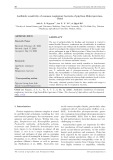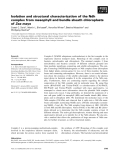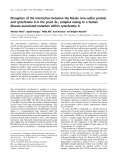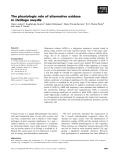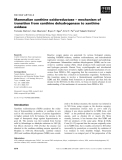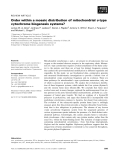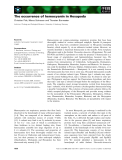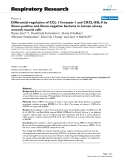
Respiratory bacteria
-
The polymerase chain reaction (PCR) for Actinobacillus pleuropneumonia (App), Haemophilus parasuis (Hps), Pasteurella multocida (Pm) and Bordetella bronchiseptica (Bb) were performed in pure colonies isolated from 114 lung specimens with lesions collected from the Vissan slaughterhouse in Ho Chi Minh City from July 2018 to May 2019
 6p
6p  larachdumlanat129
larachdumlanat129
 19-01-2021
19-01-2021
 10
10
 2
2
 Download
Download
-
This study aimed to investigate the antimicrobial resistance of five major respiratory pathogens in pigs of Hubei province, China, from October to December, 2019. Antibiotic susceptibility testing for Streptococcus suis, Haemophilus parasuis, Pasteurella multocida, Bordetella bronchiseptica and Actinobacillus pleuropneumoniae was determined to representatives of relevant antibiotic classes.
 6p
6p  larachdumlanat129
larachdumlanat129
 19-01-2021
19-01-2021
 10
10
 1
1
 Download
Download
-
Complex I (NADH: ubiquinone oxidoreductase) is the first complex in the respiratory electron transport chain. Homologs of this complex exist in bacteria, mitochondria and chloroplasts. The minimal complex I from mitochondria and bacteria contains 14 different subunits grouped into three modules: membrane, connecting, and soluble subcomplexes. The com-plex I homolog (NADH dehydrogenase or Ndh complex) from chloroplasts from higher plants contains genes for two out of three modules: the mem-brane and connecting subcomplexes. ...
 12p
12p  awards
awards
 06-04-2013
06-04-2013
 26
26
 3
3
 Download
Download
-
The mitochondrial cytochromeb missense mutation, G167E, has been reported inapatientwithcardiomyopathy. The residue G167 is located in an extramembranous helix close to the hinge region of the iron–sulfur protein. In order to characterize the effects of the mutation on the structure and function of thebc1complex, we introducedG167E into the highly similar yeast cytochromeb. The mutation had a severe effect on the respiratory function, with the activity of thebc1complex decreased to a fewper cent of the wild type....
 7p
7p  dell39
dell39
 03-04-2013
03-04-2013
 44
44
 5
5
 Download
Download
-
Type II NADH dehydrogenases (NDH-2) are monomeric enzymes that cat-alyse quinone reduction and allow electrons to enter the respiratory chain in different organisms including higher plant mitochondria, bacteria and yeasts. In this study, anAgrobacterium tumefaciensgene encoding a puta-tive alternative NADH dehydrogenase (AtuNDH-2) was isolated and expressed in Escherichia coli as a (His)6-tagged protein.
 13p
13p  inspiron33
inspiron33
 25-03-2013
25-03-2013
 39
39
 4
4
 Download
Download
-
Alternative oxidase (AOX) is a ubiquitous respiratory enzyme found in plants, fungi, protists and some bacterial species. One of the major ques-tions about this enzyme is related to its metabolic role(s) in cellular physi-ology, due to its capacity to bypass the proton-pumping cytochrome pathway, and as a consequence it has great energy-wasting potential.
 13p
13p  inspiron33
inspiron33
 23-03-2013
23-03-2013
 46
46
 4
4
 Download
Download
-
Reactive oxygen species are generated by various biological systems, including NADPH oxidases, xanthine oxidoreductase, and mitochondrial respiratory enzymes, and contribute to many physiological and pathologi-cal phenomena.
 12p
12p  galaxyss3
galaxyss3
 07-03-2013
07-03-2013
 43
43
 5
5
 Download
Download
-
Mitochondrial cytochromescandc1 are present in all eukaryotes that use oxygen as the terminal electron acceptor in the respiratory chain. Matura-tion of c-type cytochromes requires covalent attachment of the heme cofac-tor to the protein, and there are at least five distinct biogenesis systems that catalyze this post-translational modification in different organisms and organelles.
 18p
18p  media19
media19
 06-03-2013
06-03-2013
 39
39
 4
4
 Download
Download
-
Hemocyanins are copper-containing, respiratory proteins that have been thoroughly studied in various arthropod subphyla. Specific O2 -transport proteins have long been considered unnecessary in Hexapoda (including Insecta), which acquire O2 via an elaborate tracheal system.
 12p
12p  viettel02
viettel02
 22-02-2013
22-02-2013
 35
35
 3
3
 Download
Download
-
Tuyển tập các báo cáo nghiên cứu về y học được đăng trên tạp chí y học 'Respiratory Research cung cấp cho các bạn kiến thức về ngành y đề tài: " Differential regulation of CCL-11/eotaxin-1 and CXCL-8/IL-8 by Gram-positive and Gram-negative bacteria in human airway smooth muscle cells...
 8p
8p  toshiba12
toshiba12
 21-10-2011
21-10-2011
 50
50
 5
5
 Download
Download
-
Pathogenesis Hib strains cause systemic disease by invasion and hematogenous spread from the respiratory tract to distant sites such as the meninges, bones, and joints. The type b polysaccharide capsule is an important virulence factor affecting the bacterium's ability to avoid opsonization and cause systemic disease. Nontypable strains cause disease by local invasion of mucosal surfaces. Otitis media results when bacteria reach the middle ear by way of the eustachian tube. Adults with chronic bronchitis experience recurrent lower respiratory tract infection due to nontypable strains.
 5p
5p  colgate_colgate
colgate_colgate
 21-12-2010
21-12-2010
 79
79
 6
6
 Download
Download
-
Infections of the Ear and Mastoid Infections of the ear and associated structures can involve both the middle and external ear, including the skin, cartilage, periosteum, ear canal, and tympanic and mastoid cavities. Both viruses and bacteria are known causes of these infections, some of which result in significant morbidity if not treated appropriately. Infections of the External Ear Structures Infections involving the structures of the external ear are often difficult to differentiate from noninfectious inflammatory conditions with similar clinical manifestations.
 5p
5p  ongxaemnumber1
ongxaemnumber1
 29-11-2010
29-11-2010
 66
66
 4
4
 Download
Download
-
Harrison's Internal Medicine Chapter 31. Pharyngitis, Sinusitis, Otitis, and Other Upper Respiratory Tract Infections Pharyngitis, Sinusitis, Otitis, and Other Upper Respiratory Tract Infections: Introduction Infections of the upper respiratory tract (URIs) have a tremendous impact on public health. They are among the most common reasons for visits to primary care providers, and, although the illnesses are typically mild, their high incidence and transmission rates place them among the leading causes of time lost from work or school.
 5p
5p  ongxaemnumber1
ongxaemnumber1
 29-11-2010
29-11-2010
 89
89
 4
4
 Download
Download
CHỦ ĐỀ BẠN MUỐN TÌM










